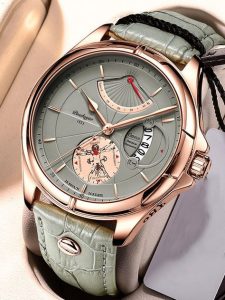Uncategorized
The Science Behind Luminous Dials in Watches
Luminous dials in watches have been a hallmark of both functionality and style for over a century. The ability to read a watch in low-light conditions or in total darkness is a highly practical feature, and it’s one that continues to be essential for many watch enthusiasts, divers, pilots, and military personnel. The science behind luminous dials involves materials that can absorb light and then re-emit it, allowing the watch to be legible even in dark environments. In this article, we’ll dive into the history, materials, and technology behind luminous dials in watches.
The Origins of Luminous Dials
Luminous watch dials date back to the early 20th century, when the need for readability in low-light conditions became more apparent. The first truly luminous watches used radium, a radioactive material, to create glowing dials and hands. While radium-based luminescence was highly effective, it posed severe health risks due to its radioactive properties. Over time, as the dangers of radium became clear, watchmakers sought safer alternatives.
Today, modern luminous watches use safer materials and technologies that allow for bright, long-lasting illumination without the health risks associated with radium.
The Science of Luminescence

Luminescence refers to the emission of light by a material that has absorbed energy. There are two primary types of luminescence that are used in watches:
- Photoluminescence: This is the most common form of luminescence used in watches. It occurs when a material absorbs light (usually ultraviolet or visible light) and then re-emits it over time. This is the principle behind most modern watch lume (the glowing material on watch hands and dials).
- Electroluminescence: This is a less common form of luminescence and is used in some digital watches or watches with built-in backlighting. Electroluminescence occurs when an electric current passes through a phosphor material, causing it to emit light.
In the case of watch dials, photoluminescent materials are the most widely used due to their safety, ease of application, and the ability to produce a glowing effect without requiring batteries or electricity.
Materials Used in Luminous Dials
The evolution of luminous materials has been driven by the desire for greater safety, longer-lasting brightness, and improved effectiveness. Here are the most common materials used in modern luminous dials:
1. Super-LumiNova
Super-LumiNova is the modern standard in luminous watch technology. It’s a non-radioactive, photoluminescent pigment developed in the 1990s as a safer alternative to radium and tritium. Super-LumiNova is composed of a combination of rare earth elements, including strontium aluminate, which is the key component responsible for its glow. It works by absorbing ambient light (such as sunlight) and then re-emitting it over time.
Key Features of Super-LumiNova:
- Safety: Unlike radium and tritium, Super-LumiNova is non-radioactive and completely safe to handle.
- Longevity: It can glow for hours after being charged by light, though it does fade over time. The intensity of the glow depends on the amount of light absorbed.
- Color Options: Super-LumiNova is available in different colors, with green and blue being the most common for watch dials. Some watches use a mix of different colors to enhance visibility.
2. Tritium
Tritium is a radioactive isotope of hydrogen and was once commonly used in watches for its ability to glow continuously without needing to be “charged” by light. Tritium emits light due to its radioactive decay, and it doesn’t require external light sources for activation. However, due to the safety concerns associated with radioactive materials, tritium is no longer used in most mainstream watches.
Key Features of Tritium:
- Continuous Glow: Unlike Super-LumiNova, tritium doesn’t require charging and provides continuous luminescence.
- Radioactive: Tritium emits low levels of radiation, which is safe as long as the material remains contained in the watch, but it can be hazardous if the watch is damaged.
- Fading: Tritium will eventually lose its luminosity as the material decays, which means that over time, tritium watches will gradually dim.
Today, tritium is used in limited quantities, primarily in specialized watches, and is typically housed in tiny glass vials known as “H3” tubes, which are sealed inside the watch case.
3. Luminova (Non-Super)
Luminova is an earlier version of Super-LumiNova and was widely used in watches before the development of its more advanced counterpart. It functions on the same photoluminescence principle but tends to have a shorter glow duration compared to Super-LumiNova.
While not as efficient or long-lasting as Super-LumiNova, Luminova still offers a safe, reliable glow that makes it a common choice in lower-priced watches or older models.
How Does Luminous Paint Work?
Luminous paint or pigment is applied to the hands, hour markers, and sometimes the dial of a watch. The process involves applying a thin layer of photoluminescent pigment to specific areas of the watch dial or hands. When exposed to light, these areas absorb energy, which is stored in the pigments. Once the light source is removed, the pigments begin to release the stored energy as visible light, causing the watch hands or markers to glow.
The strength of the glow depends on several factors, including:
- Exposure Time: The longer the watch is exposed to light, the brighter the glow will be.
- Type of Luminous Material: Some materials, such as Super-LumiNova, glow longer and brighter than others, like Luminova.
- Thickness of the Application: The thicker the layer of luminous pigment, the more light it can absorb and the longer it can glow.
Factors Affecting Luminous Performance
While luminous dials are highly functional, several factors can affect their performance and longevity:
1. Type of Light Exposure
The brightness and duration of the glow depend largely on the type of light the watch is exposed to. Sunlight or bright artificial light is ideal for charging the luminous pigment. However, watches that are exposed only to dim or artificial light may not charge as effectively, leading to a weaker glow.
2. Age of the Watch

Over time, luminous materials can lose their effectiveness. Super-LumiNova, for instance, will gradually lose its intensity after many years of use. However, it can be recharged with exposure to light, and the materials used today are more durable than older forms of luminescence.
3. Thickness of Application
The thickness of the luminous material applied to the watch’s dial and hands plays a key role in how long and how brightly it glows. Watches with a thicker layer of luminous material generally emit a brighter, longer-lasting glow.
4. Environmental Conditions
Exposure to extreme heat, moisture, or wear and tear can also affect the longevity of a watch’s luminous dial. Regular cleaning and careful handling can ensure that the luminous material performs optimally for longer.
Conclusion
Luminous dials in watches are not only functional but also fascinating from a scientific standpoint. From their origins using radium to the modern-day use of non-radioactive materials like Super-LumiNova, the evolution of luminous technology in horology has led to brighter, safer, and longer-lasting dials. Whether you’re a diver, adventurer, or simply someone who enjoys the aesthetics of a glowing dial, understanding the science behind luminous watches adds another layer of appreciation for these incredible timepieces. As technology continues to improve, it’s exciting to think about what new innovations will light up the watch industry in the future.

